Posts Tagged ‘capt thomas s calhoon’
Sunday, October 4th, 2015
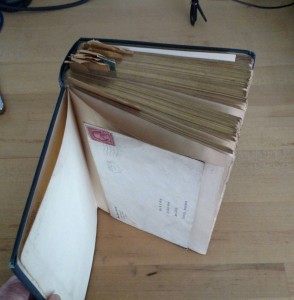
Transportation in the Ohio Valley fly leaf.
My reading this week has been “A History of Transportation in the Ohio Valley” by Charles Henry Ambler published in 1931. The first edition history was lent to me by Michael Libenson who is the great great grandson of Capt Thomas Stevenson Calhoon. The many comments and corrections hand written in the margins of the book make this book special. Those comments were written by Harriet Darrington (Calhoon) Ewing (b ? d 1950), the daughter of Capt Thomas S Calhoon and great grandAunt of Michael Libenson. Her writing is the closest thing we have to a voice into these steamboat captains lives. Mrs WH Ewing dated her copy of the book Oct 26, 1931.
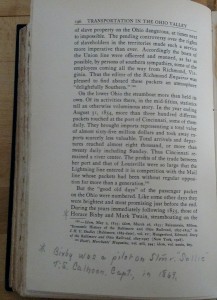
Transportation in the Ohio Valley p173.
Along with her notes, Harriet D Calhoon taped a response letter from CH Ambler to the front flyleaf. The response, on West Virginia University letterhead, was dated 13 Aug 1930. The content of the letter indicated that the exchange of information was too late to be included in the forthcoming book. Whether a meeting or additional correspondence between them ever took place is unclear. There is no record of such a meeting and no updated edition of the book.
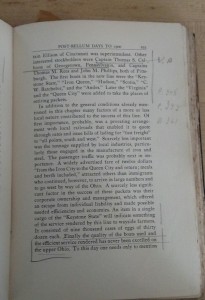
Transportation in the Ohio Valley p293.
Harriet D Calhoon is well known to those with long memories. Often Capt Frederick Way used her comments in articles about Georgetown in the S&D Reflector. See Vol 2 No 4 Dec 1965 p10,12.
My final comment/concern is how many books similar to this history written by captains or pilots have I missed?
Copyright © 2015 Francis W Nash All Rights Reserved
No part of this website may be reproduced without permission in writing from the author.
Tags: capt jackman t stockdale, capt thomas s calhoon, mark twain
Posted in History of Georgetown PA, River history, Steamer Captains | No Comments »
Sunday, September 20th, 2015
As my wife says, I never tire of telling Georgetown steamboat stories which is Oldspeak for boring people to death. That as background, my presentation to the Beaver Area Heritage Foundation was the highlight of my summer. There I met many interesting people with a bent for local history. Every lecture I do I learn something. Sometimes, like at BAHF, I Iearn a lot.
On Mon before the BAHF presentation, I received an email from the great-great-grandson of Thomas S Calhoon = Mr Mike Libenson. Mr Libenson was planning to visit Georgetown with his daughter on Sat and notified me via GeorgetownSteamboats. From Boston, they carried gifts of gold: a book published in 1932 on Ohio Rriver Transportation and photos of Poe men that I had been unable to identify. In addition to those items, Mr Libenson also has a complete genealogy of the Calhoon, Poe, and Parr families prepared by Dr John Ewing, Capt Thomas S Calhoon’s grandson. I plan spending much time with that volume.
While visiting the Georgetown Cemetery with the Libensons, we spoke to Mr Tom Lombard who is the president of the Georgetown Cemetery Maintenance Association (donations greatly apppreciated). Mr Lombard provided the history of the Calhoon cemetery lot, and others, plus a map of the cemetery with every stone marked and accommpanied by a listing by name, where legible, of the people interred. The map and listing are a fantastic find that I will compare/merge with work already in progress.
Copyright © 2015 Francis W Nash All Rights Reserved
No part of this website may be reproduced without permission in writing from the author.
Tags: capt thomas s calhoon, georgetown
Posted in History of Georgetown PA, River history, Steamer Captains | No Comments »
Friday, August 1st, 2014
Mr Myron Elliot recently visited me in Carlisle, PA. He was “walking Gettysburg” yet took some time to visit me. He wanted to use some of the Georgetown local history on this site at the community tent at the Hookstown Fair. The 2014 fair will run from 19-23 Aug.
The rich early history of the south side of the Ohio River is based largely on eye witness accounts described in letters, journals, and a few books. The stories are fantastic. Most of the original documents have been lost forever or are maintained in private collections. Either way original sources are scattered and hard to come by.
If you are in the area, make time to visit the Hoookkstown Fair and its Historic Village.
Copyright © 2014 Francis W Nash
All Rights Reserved
Tags: adam poe, capt george w ebert, capt thomas s calhoon, georgetown, jacob poe, ohio river steamboats
Posted in History of Georgetown PA, River history | No Comments »
Thursday, September 12th, 2013
In Jan 2012, Kevin Mahoney contacted me through GeorgetownSteamboats. His interest was the Pittsburgh and Cincinnati Packet Line. Specifically, he was interested in William (Capt Billy) Anderson, his great great grandfather. Thanks to Capt Benjamin M Laughlin, I have some unique information on the Pitt-Cin Packet Line. My information, however, pales in comparison to the Mahoney treasure-trove.
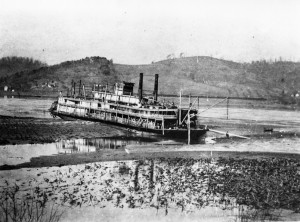
Str Virginia in cornfield in 1910 (courtesy of the Public Library of Cincinnati and Hamilton County)
Capt Billy Anderson was the pilot of the str Virginia on 6 Mar 1910 - the night of the cornfield episode. One passenger wanted to debark at Willows Grove, WV. The passenger’s ticket represented a transaction of fifty cents. Pilot Billy Anderson argued that the stop was too dangerous with the high water; Capt Charles Knox convinced him to try. That night the str Virginia parked securely between cornstalks six hundred feet from the river channel. For six long months the str Virginia was aground – sitting high and dry on fertile soil. Robins built nests in the pilothouse; mudwasps constructed hives in the shelter of the decks. An archaeologist from the Ohio State Historical Society said the str Virginia was stuck on an Indian mound when artifacts were dug under the hull. A sad state for the proud str Virginia.
Mr Mahoney has family and steamboat photos and stories written by Capt Billy’s daughter. It is a bit of American history that should be made public.
Copyright © 2013 Francis W Nash
All Rights Reserved
Tags: capt thomas s calhoon, ohio river steamboats, Pittsburgh Cincinnati Packet line
Posted in River history, River Tales, Steamer Captains | 1 Comment »
Wednesday, May 1st, 2013
One hundred fifty years ago today, the str Horizon collided with the streamer str Moderator. Both boats were running after dark on a moonless night without lights, making evasive moves, and badly riddled by rebel cannons. Never had steamboats faced a more firey ordeal. The str Moderator had been damaged to the degree that it was unmanageable. The Horizon was not in trouble until the collision with the Moderator. Both vessels sunk. The str Horizon sunk on Island No 10 near Grand Gulf, MS.
Many soldiers, including Swedish members of Stolbrand’s Battery, were lost when the str Horizon sank. [1] In an eyewitness report one day later Gen Isaac H Elliot wrote, “I was down to the str Horizon and succeeded in getting out three gun carriages, but the stench arising from the 60 dead horses and men made my officers and men sick.” [2]
According to The Lytle-Holdcamper List ― Lives lost “Unknown”.[3]
According to the Gibsons, the US government paid $18,500 for the loss of the packet.[4] It is true that the owners applied for compensation, but two applications for indemnity were rejected by the US Army Quartermaster. I have no knowledge of any compensation received. At the time of the collision, the owners of the str Horizon were John N McCurdy, Thomas S Calhoon, Richard Calhoon, and William White (Jackman T Stockdale had sold his share in late 1862).[5]
References.
[1] Frederick Way, Jr.,Way’s Packet Directory, 1848-1994, (Ohio University Press, Athens 1994), p. 217.
[2] Gen Issac H Elliot,. Thirty-Third Regiment Illinois Veteran Volunteer Infantry In the Civil War.
[3] William M Lytle and Forrest R Holdcamper, Merchant Steam Vessels of the United States 1790-1868, (The Steamship Historical Society of America, Inc, 1975), p272.
[4] Charles Dana Gibson and E Kay Gibson, Dictionary of Transports and Combatant Vessels Steam and Sail Employed by the Uniion Army 1861 – 1868, (Ensign Press, Cambridge, MA 1995), p 152.
[5] John H Ewing, Biography of Thomas S Calhoon, Heinz History Center, The Ewing Papers Box 5, p 17.
Copyright © 2013 Francis W Nash
All Rights Reserved
Tags: capt jackman t stockdale, capt thomas s calhoon, civil war transports, general isaac H Elliot, stolbrand's battery, The Lytle-Holdcamper List
Posted in Civil War Steamers, History of Georgetown PA, River history, Steamer Captains | No Comments »
Monday, April 22nd, 2013
On this day 150 years ago, the str Horizon ran the Vicksburg and Grand Gulf batteries with supplies. Her civilian crew, except for her pilots, was temporarily replaced by Army officers and soldiers. Badly damaged by shell fire, she ran the gauntlet successfully. [1] According to the regimental history of the 11th Illinois Infantry, Second Lieutenant James D. Vernay of Company B received the Medal of Honor. He had been detached as a volunteer to the steamer Horizon during the Vicksburg campaign. The medal was issued for “Served gallantly as a volunteer with the crew of the steamer Horizon that, under a heavy fire, passed the Confederate batteries.”. [2]
The str Horizon was one of six transport steamers repaired to run the Vicksburg batteries after the failures of the “bayou” expeditions. On 22 Apr 1863, Capt GW Kennard 20th IL Regiment commanded the str Horizon. His boat left Millikin’s Bend at 9:00 PM. She steamed slowly to the bend then put on a “full head of steam”. At the second battery two artillery shots crashed through the bulkhead. At the next battery two shots hit the hurricane deck. In total fifteen or sixteen shots hit their target. All were forward and above the boiler room.
After passing the batteries, the str Horizon attempted to go to the assistance of the disabled str Moderator without success. The str Horizon then went to the aid of the str Anglo-Saxon. Later that day, the str Horizon was ordered to pass the Warrenton battery a second time and report at New Carthage. The str Horizon ”steamed up and reported” at New Carthage.[3]
Think for a moment about the power of the Medal of Honor. To single out for honor one person aboard one steamer would be a fascinating subject to explore.
How different the Civil War would have been without the Ohio River effectively separating much of the nation, North and South! And how different would have been the outcome without the steamboat , Union men, who knew the chutes, channels, and shoals of the Ohio and its tributaries.
References.
[1] Charles Dana Gibson and E Kay Gibson, Dictionary of Transports and Combatant Vessels Steam and Sail Employed by the Union Army 1861 – 1868, (Ensign Press, Cambridge, MA 1995), p 152.
[2] Regimental History of the 11th Illinois Infantry.
[3] JK Folmar I, California, PA 1849-1881: The History of a Boat Building Town, (Yohogania Press, California, PA 2009), p 58.
Copyright © 2013 Francis W Nash
All Rights Reserved
Tags: capt thomas s calhoon, civil war transports, georgetown, ohio river steamboats, vicksburg
Posted in Civil War Steamers, History of Georgetown PA, River history, Steamer Captains | No Comments »
Friday, December 28th, 2012
It is important to acknowledge that the Georgetown steamboat owners and their crews were in the river freight and passenger business at the sharp and dangerous, and always moving, frontier edge of our nation. Without them and men like them, the development of the interior of our nation would have been delayed many years.
I have added a page to tell their story: Lower Missouri River.
Copyright © 2012 Francis W Nash
All Rights Reserved
Tags: adam poe, capt george w ebert, capt thomas s calhoon, capt thomas w poe, catp jackman t stockdale, georgetown, jacob poe, missouri river, missouri river steamboat
Posted in History of Georgetown PA, Missouri River Commerce, River history, Steamer Captains | No Comments »
Sunday, September 16th, 2012
Last Thursday (6 Sep 2012), I spent another afternoon and early evening at the National Archives in DC. I reviewed the Certificates of Enrollment records (Record Group 41) from 3 Jan 1859 through 23 Dec 1862 (Volumes 6641-6644). Sadly, volumes 6643 and 6644 were water damaged. Their condition was disastrous. For many entries the ink was completely washed out and incomprehensible. I know not whether a conservator could recover the data. In addition to the ruined volumes, there was no volume for the year 1862. This catastrophe is a dreadful loss because the time frame extends through the period of the Civil War when approximately fifty percent of the civilian steamboats impressed or chartered for service on the western rivers by the US Army Quartermaster were built in the Pittsburgh region.
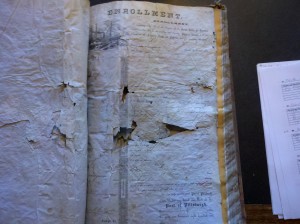
Enrollment Record in Volume 6643 (F Nash 6 Sep 2012)

Enrollment Record from Volume 6644 (Fnash 6 Sep 2012)
On a more positive note, I found two (2) new keel boats built by Georgetown rivermen. The last of these unexpected discoveries was built by HW Laughlin in Industry, PA and registered on 1 May 1861. This discovery should dispel some illusions that keel boats were quickly displaced by the technological superior steamboats. Low water was the spur of necessity that favored the keel boat to this late date.
Only twenty-eight volumes of the Certificates of Enrollment for Pittsburgh to review before my National Archives research will be complete. That said, since I last viewed the Vessel File (Record Group 92), I have discovered that I have doubled the number of steamboats from Georgetown. In addition to the Vessel File, I was pointed to the Index of Claims for the Army Quartermaster. There was an index entry for Thomas S Calhoon (str Horizon), but none for Thomas Poe or Jacob Poe (str Clara Poe). If time permits, I will also review the Preliminary Inventory of the Textual Records of the office of the Quartermaster general – Part 1 Vessel records.
The National Archives is a fascinating place to explore rare and monumental artifacts.
Copyright © 2012 Francis W Nash
All Rights Reserved
Tags: capt thomas s calhoon, capt thomas w poe, jacob poe, national archives, ohio river steamboat, str clara poe, str horizon
Posted in Civil War Steamers, History of Georgetown PA, River history, Steamer Captains | No Comments »
Friday, June 15th, 2012
It’s half past Halloween or so, and the Georgetown Cemetery has had an unusual high number of visitors in Jun 2012. I know not why?!? Maybe it is a derivative of the crew of Kent State ghost busters who captured on film an evening at the cemetery.
The Ghost Box video is a fun view. My bio of the cemetery is a more revered read. Undoubtedly, video always trumps paper.
The Georgetown Cemetery List was a found-by-chance document included in the inherited boxes of documents and photos. I do not know the author of the list nor its date. However, it appears to be accurate.
Of great interest to me is the new threat to the cemetery. That threat is the potential harm to the cemetery, and Georgetown, from the blasting associated with local fracking. A drilling platform will soon be built near the cemetery.
Copyright © 2012 Francis W Nash
All Rights Reserved
Tags: capt thomas s calhoon, fracking, georgetown, old cemetery
Posted in History of Georgetown PA | No Comments »
Tuesday, March 27th, 2012
I spent a couple of fun days in DC. BTW, the cherry blossoms are over. Sherron spent her time visiting museums and art galleries, and of course shopping in Georgetown. Together we did make time to observe the art display, “Suprasentorial”, on the Hirshorn Museum. And I do mean on the museum. The work was projected on the exterior walls of the museum – the entire surface – accompanied by many versions of the song “I only have eyes for you”. It shows dusk to midnight till the May 13. Quite impressive with Jupiter, Venus, and the moon aligned just above the museum from the sculpture garden.
While Sherron was touring, I was playing at the National Archives. I wanted to seriously review the Certificates of Enrollment from the Navigation Customhouse of Pittsburgh, PA (National Archive Records Administration Record Group 41). There are forty-nine (49) volumes covering the period between 5 Jan 1831 and 28 Jun 1901. I reviewed four volumes in two days. Do the math. It will takes a serious commitment of time to review all the records. Who is next the William M Lytle or Forrest R Holdcamper or Frederick Way, Jr character willing to dedicate a lifetime to compile this data from all the Customhouses into a modern data base application? Till that person is discovered I intend to put the Pittsburgh Customhouse data related to my Georgetown guys online so it will be available in at least two places.
At the National Archives, I learned some amazing stuff. For example, Georgetown river men continued to build keel boats through 1854. Jacob Poe built a keel boat named Big Foot in 1850. As you probably know, his brother Adam built the str Big Foot in 1875. The dimensions of the keel boat Big Foot were biblical. On the Certificate of Enrollment the length was 114 ft, breadth 17 feet 3 inches, and depth 1 foot 7 inches. Most of the Georgetown keel boats were rated between 25 and 50 tons. I intend to add keel boat data to my Xcel spreadsheet of steamboats and tugs.
In addition to the newly learned keel boat information, I discovered new Georgetown names associated with the river business. The Certs of Enrollment list the original owners which I intend to add to my steamer biographies. That process too will take some time.
In sum, two days of vacation has introduced an assortment of new information and generated the energy to develop the new topics.
Copyright © 2012 Francis W Nash
All Rights Reserved
Tags: adam poe, Benjamin M Laughlin, capt george w ebert, capt jackman t stockdale, capt thomas s calhoon, capt thomas w poe, georgetown, jacob poe, joseph calhoon, keel boat, Nationa Archives
Posted in History of Georgetown PA, River history, Steamer Captains | No Comments »





